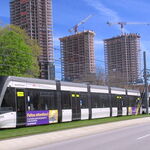Bordercollie
Senior Member
ave to: it's only our North American conception of "Commuter Rail" which tells u
Maybe it will get better as time goes on.
Already a significant delay (25 mins) rolling into S. Mary’s :/
ave to: it's only our North American conception of "Commuter Rail" which tells u
Maybe it will get better as time goes on.
Already a significant delay (25 mins) rolling into S. Mary’s :/
Im honestly ashamed that our passenger rail reliability standards are this low that we can just brush off even a 10 minute delay as acceptable. If any of this happens on a frequent basis overseas, investigations would be launched managers would be out the door almost immediately. This is one of the big reasons why passenger rail in NA is just pure garbage vs any where else, even india.According to that live-tweet feed, the train departed Kitchener precisely 30 minutes late and followed the schedule of the subsequent express train (arriving Union 9:43). GO pulled another train out of the yard early to run the Kitchener-Toronto trip which arrives at 9:13, which the London train should have filled.
The GO train then arrived in Union precisely 30 minutes late from the perspective of London-Stratford passengers (on time for Kitchener-Toronto passengers), clocking in a brutal 4h23 travel time from London to Toronto (45 km/h average).
But a 30 minute delay is still better than VIA 84, which seems to be on track to arrive 49 minutes late today:
The train is currently sitting at Wice (Pearson Junction) presumably waiting for an UP Express train to cross. This is what happens when you enter a busy tightly-scheduled rail corridor at unplanned times.
(Times are 6h off because my computer is set to Central European Time)
Yet again, the VIA train arrived in London on time, but accumulated a major delay before St Marys, which then continued to get even worse until Kitchener. This supports our theory that VIA's 1h56 scheduled London-Kitchener travel time is way out of date, and GO's 2h12 estimate is far more representative of the current state of disrepair.
Delays along the line:
0 Strathroy
+2 London
+23 St Marys
+31 Stratford
+39 Kitchener
+38 Guelph
+39 Georgetown
+39 Brampton
+42 Malton
Small investment in track infrastructure would go a long way in improving travel times.Im honesty ashamed that our passenger rail reliability standards are this low that we can just brush off even a 10 minute delay as acceptable. If any of this happens on a frequent basis overseas, investigations would be launched managers would be out the door almost immediately. This is one of the big reasons why passenger rail in NA is just pure garbage vs any where else, even india.
Hopefully if this pilot project is successful, Metrolinx will but the subdivision and improve the track. I’m sure CN is fine with selling as it’s not their mainline.Small investment in track infrastructure would go a long way in improving travel times.
Guess we will need to wait for the track to change hands before we see any improvement
So why did they take it back from GXER?The GO bulletin attributed this morning’s delay to interference from a freight train.
Yeah…. Even on a lightly used route.
- Paul
Perhaps to sell it to the government, make money, and retain running rights.So why did they take it back from GXER?
Better than that, even. When leased to GEXR, the line was in better shape. Reportedly the terms of the lease included a stipulation that CN could recoup costs from GEXR if the line was turned back in poorer shape than when leased. Apparently CN did get money back from GEXR….. but this money was not put back into the line. It was retained as earnings.Perhaps to sell it to the government, make money, and retain running rights.
I was wondering why they didn't chose #3960 to originate in London, as it would have given much more attractive timings to leave London (05:50), St. Marys (06:43), Stratford (07:13) and to arrive in Kitchener (08:02) and Guelph (08:23). I figured as much as they wouldn't want to extend a local train (e.g. #3812), given how much people obsess about end-to-end times, but had they indeed chosen #3960, bumping the train on the next departure (Local train 3812, dep. Kitchener at 08:39) would have resulted in a arriving at Union not just 30, but 45 minutes:According to that live-tweet feed, the train departed Kitchener precisely 30 minutes late and followed the schedule of the subsequent express train (arriving Union 9:43). GO pulled another train out of the yard early to run the Kitchener-Toronto trip which arrives at 9:13, which the London train should have filled.
The GO train then arrived in Union precisely 30 minutes late from the perspective of London-Stratford passengers (on time for Kitchener-Toronto passengers), clocking in a brutal 4h23 travel time from London to Toronto (45 km/h average).
The majority (15 minutes) of these delays were caused by a CP train blocking the diamond in London, so unrelated with freight traffic on the Guelph Subdivision itself:The GO bulletin attributed this morning’s delay to interference from a freight train.
Yeah…. Even on a lightly used route.
- Paul
To be fair: I very much doubt it would have been easier to purchase this asset from CN, had they renewed GEXR's long-term lease in 2018...Better than that, even. When leased to GEXR, the line was in better shape. Reportedly the terms of the lease included a stipulation that CN could recoup costs from GEXR if the line was turned back in poorer shape than when leased. Apparently CN did get money back from GEXR….. but this money was not put back into the line. It was retained as earnings.
So CN apparently monetised the downgrading of the line, and has now left ML and VIA with the cost of bringing it back up to snuff.
How’s that for clever ?
- Paul
I was wondering why they didn't chose #3960 to originate in London, as it would have given much more attractive timings to leave London (05:50), St. Marys (06:43), Stratford (07:13) and to arrive in Kitchener (08:02) and Guelph (08:23). I figured as much as they wouldn't want to extend a local train (e.g. #3812), given how much people obsess about end-to-end times, but had they indeed chosen #3960, bumping the train on the next departure (Local train 3812, dep. Kitchener at 08:39) would have resulted in a arriving at Union not just 30, but 45 minutes:
Which makes you wonder at how much projected delay at Kitchener is the cut-off for sending 3960's equipment as 3760 instead...
To be fair: I very much doubt it would have been easier to purchase this asset from CN, had they renewed GEXR's long-term lease in 2018...
I guess VIA has no say about how the host railway maintains the track.When the departure from London is so extremely early, it does detract from the argument that this train is about travel between points west of Toronto. Pushing the departure to align to one Kitchener departure later would improve the timing for anyone coming into Kitchener for the day.
No doubt. But it demonstrates just how little obligation CN and CP have to maintain their network in a way that enables passenger service. It takes an old but intangible argument to a very tangible reality.... it has always been an accounting exercise to determine if a railway is spending more to maintain a line by virtue of it handling passenger service. In this case, the line was actually reduced in quality over time (albeit by neglect, rather than a business decision, perhaps) and CN harvested whatever investment might have been made in the past for passenger quality track. Perhaps that investment will be reinserted as public investment.
- Paul
No, this is what happens when you get an organization so focused on one, highly specific thing or metric - On-Time Performance - that everything else ends up going down the shitter.But a 30 minute delay is still better than VIA 84, which seems to be on track to arrive 49 minutes late today:
The train is currently sitting at Wice (Pearson Junction) presumably waiting for an UP Express train to cross. This is what happens when you enter a busy tightly-scheduled rail corridor at unplanned times.

I guess VIA has no say about how the host railway maintains the track.




